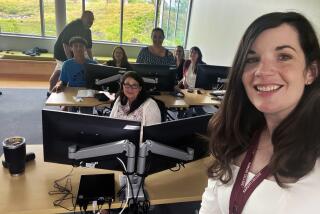Forensic Scientists Find Proof DNA Tool Works : Crime-solving: Anaheim convention of investigators shows how genetic ‘fingerprinting’ has gained acceptance.
- Share via
ANAHEIM — A few years ago, when deoxyribonucleic acid was the latest and hottest tongue-twister to hit the forensic community, Keith Inman recalls that there might have been a single session on the topic at the annual forensics convention.
But this week, as coroners, cops, pathologists and others in the business of crime-solving gather at the Anaheim Marriott for the 43rd annual meeting of the American Academy of Forensic Sciences, the impact of the genetic “fingerprinting” tool known as DNA is everywhere--at panel discussions, in the exhibit showroom, in hallway debates.
“This itself is proof of the dynamism of what’s happening,” said Inman, a senior criminalist with the state Justice Department’s DNA lab in Berkeley. “The reason DNA is seen as so incredibly important is that it answers one of the most critical questions in criminal cases--who done it?”
The genetic pattern found in DNA, thought to be unique in each person, can allow investigators to identify criminal suspects--particularly sex offenders--through minute specimens of hair, blood, semen and other physical evidence.
Orange County, which runs one of the few self-supporting county DNA labs in the country at a cost of about $230,000 a year, is leading the rush to apply such practical uses of DNA research. The county also is taking part this spring in a pilot program coordinated by the FBI that will test the viability of exchanging DNA data across the nation.
Some in the scientific community still question the reliability and cost of the new method. But following the opening of Orange County’s DNA lab last May, genetic fingerprinting led to the positive identification of two suspects and the exoneration of three others, according to a county report last November that gave the new lab generally positive reviews.
“Three years ago, if you had been to the exhibit section (at the convention) you wouldn’t have seen anything about DNA,” said Frank Fitzpatrick, director of forensic science at the Orange County Sheriff’s Department. “Now at least a third (of the exhibits) tend to be DNA-related--that speaks to its general acceptance and application.
“It’s now becoming a very generally applied technique that is going to become routine, and because of that, we’ll have a higher level of identification of subjects,” Fitzpatrick added.
“DNA is the hot thing right now,” said Enrico Tugneri, who heads the Washoe County, Nev., forensic science division in Reno, and is treasurer of the forensic academy.
In Tugneri’s view, legal and scientific debate about the reliability of DNA as a means of identifying criminals has been largely resolved, leaving now the technical questions about how best to apply the technique quickly and efficiently.
The conference, running through Saturday, has attracted 2,000 participants, including forensic scientists from 15 counties around the globe--the farthest away being Australia--and is the biggest of its kind in the country, according to forensic academy executive director Anne Warren.
With violent crime and public concern on the rise, DNA identification has become increasingly valuable in providing hard evidence against criminals, Tugneri said, .
“We call it the ‘Quincy’ syndrome,” he said, referring to the popular television show of the late 1970s and early ‘80s about a crime-solving forensic pathologist. “The public has seen a lot of shows on TV where they see that physical evidence has proven a case, so now the juries have come to expect that.”
But not everyone is sold on the latest wonder-tool for crime fighters.
“Eighty-five percent of the people here are DNA people,” complained Jay Siegel, a chemist who heads the forensic science program at Michigan State University and questions the reliability of DNA compared to more traditional crime-detection methods. “I’d like to see a little bit more done in other areas. It’s a little frustrating.”
More to Read
Sign up for Essential California
The most important California stories and recommendations in your inbox every morning.
You may occasionally receive promotional content from the Los Angeles Times.










